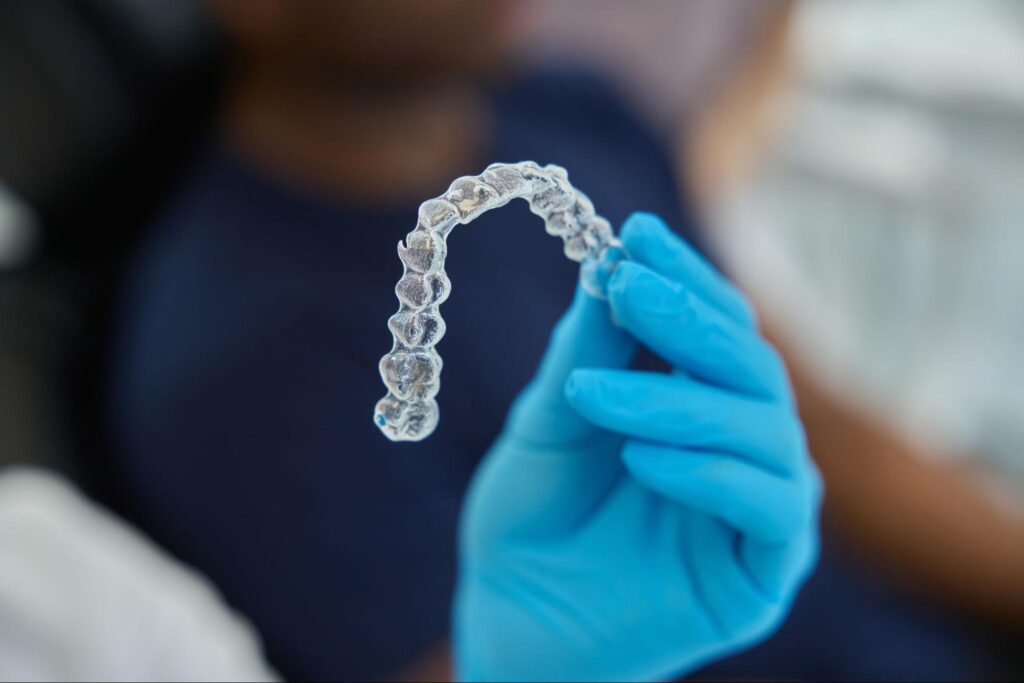Ordering clear aligners online might sound like an easy way to straighten your teeth, but what happens when things don’t go as planned? Without in-person supervision, small issues can turn into big problems, leading to damage that could take years—and a lot of money—to fix. Dr. Heinz and his team at Heinz Orthodontics have seen firsthand how direct-to-consumer (DTC) aligners can cause more harm than good. Before trusting your smile to a mail-order company, let’s take a closer look at the risks no one talks about.
What Gets Overlooked When You Skip The Check-Up?
Would you let a stranger renovate your house without inspecting the foundation first? That’s essentially what happens with direct-to-consumer (DTC) aligners. Dr. Heinz thoroughly evaluates teeth, gums, and jaw structure before starting your orthodontic treatment, but DTC companies rely on self-made impressions and quick virtual assessments (No measurements, x-rays, or diagnoses can be made virtually!). That’s like diagnosing a car problem through text messages—it just doesn’t work!
What Could Go Wrong?
- Gum disease on the loose – Moving teeth, when gums aren’t healthy, can lead to recession or even tooth loss.
- Cavities hiding under aligners – Trapped decay worsens quickly without regular check-ups.
- Weak bone, big problems – Teeth need a strong foundation; shifting them without checking bone density can create long-term issues.
Skipping a professional evaluation is a gamble—one that could cost more time, money, and frustration later. And the risks don’t stop there—when aligners aren’t designed for your teeth’s exact needs, the results can be unpredictable. Let’s take a closer look at why customization matters.
One-Size-Fits-All? Not Quite.
Orthodontic treatment isn’t a one-size-fits-all process, but that’s exactly how DTC aligners approach it. Instead of a personalized plan created by an experienced orthodontist, these companies rely on pre-set trays based on digital scans or self-made impressions. Without in-person oversight, there’s no room for adjustments if your teeth don’t move as expected.
Without proper customization, several problems can arise:
- Teeth moving unpredictably – Aligners need to be adjusted throughout treatment, but DTC companies don’t provide in-person check-ins or any monitoring during active treatment.
- New bite issues – An improper bite can lead to difficulty chewing, jaw pain, and uneven tooth wear.
- Higher costs in the long run – Many patients turn to orthodontists to correct problems caused by DTC aligners, spending more money than if they had started with professional care.
- Teeth not fully straightening – Without monitoring, some teeth may stop moving before reaching their ideal position, leaving patients with incomplete results.
- Gum and bone damage – Shifting teeth without assessing gum health or bone density can lead to irreversible damage over time.
Getting a smile you love takes more than just shifting teeth—it requires careful planning and monitoring. But when something goes wrong with DTC aligners, the consequences can be more than just a minor inconvenience. Let’s look at the real risks of unsupervised treatment.

The Cost of Convenience: When Shortcuts Backfire
DTC aligners promise an easy, hassle-free way to straighten teeth, but what they don’t advertise is what happens when things go wrong. Without regular in-person checkups by a professional like Dr. Heinz, even minor alignment issues can spiral into bigger problems. Teeth that move too quickly or in the wrong direction can cause lasting damage, some of which can’t be reversed.
Bite Problems That Make Everyday Life Harder
A poorly planned treatment can leave teeth out of sync, making it harder to chew comfortably. Some patients experience increased tooth sensitivity or even lose teeth because the supporting bone structure wasn’t strong enough for unsupervised movement. Others develop gaps where none existed before, or worse—teeth that don’t fully straighten, requiring additional treatment to correct.
Jaw Pain and Headaches: An Unexpected Side Effect
When aligners apply uneven pressure, the jaw can become strained, leading to tension, discomfort, and even chronic headaches. A misaligned bite can put extra stress on the temporomandibular joint (TMJ), creating pain that lingers long after treatment ends.
Fixing the Damage Isn’t Cheap
Stopping treatment doesn’t automatically reverse the effects of poorly planned aligner use. Many patients need extensive orthodontic work—sometimes even surgery—to correct the damage. What started as a budget-friendly option can end up costing far more than if treatment had been done correctly from the start.
Clear aligners can be a great option, but they require expert oversight. And that’s exactly what’s missing with DTC companies. Let’s look at why having a trained orthodontist involved makes all the difference.
Why Orthodontist Oversight Matters
Without professional oversight, aligners can shift teeth in the wrong direction, cause bite issues, or leave results that don’t last. Dr. Heinz and his team at Heinz Orthodontics create treatment plans that not only straighten teeth but also improve overall bite function and stability—something DTC companies simply can’t offer.
What Makes Orthodontist-Led Treatment Different?
Regular Checkups Keep Treatment on Track
- Teeth don’t always move predictably, which is why in-person visits or remote digital monitoring allow for timely adjustments.
- Without refinements, aligners may stop working effectively, leaving teeth partially shifted or even misaligned.
A Treatment Plan Designed Just for You
- Orthodontists assess bite, jaw function, and tooth structure before planning treatment.
- Aligners are adjusted as needed to prevent complications like gaps, uneven wear, or shifting teeth.
Help Is Available When You Need It
- If a bracket or aligner isn’t fitting correctly, an orthodontist can fix it right away.
- DTC patients often rely on chatbots, emails, or generic advice instead of expert care.
Without professional guidance, patients often end up needing corrective treatment later—costing more time, money, and frustration. Choosing expert-led care from the start is the best way to get safe, lasting results!

Skip the Shortcuts, Choose the Experts
A straighter smile should never come at the cost of your oral health. While DTC aligners might seem like a quick fix, the hidden risks can lead to long-term complications, extra expenses, and frustrating results. Dr. Heinz and the team at Heinz Orthodontics in Rockford and Grand Rapids offer expert-led care to make sure your treatment is safe, effective, and built to last. Schedule a complimentary consultation today!

